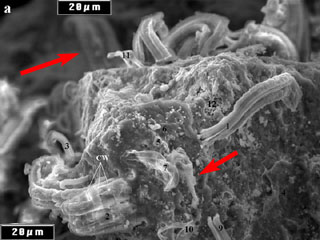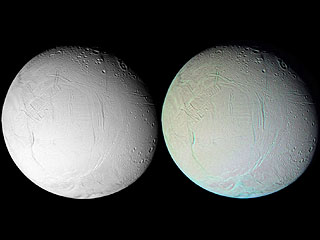NASA Scientist Discovers Alien Life in Meteorites - Again! NOT!

Introduction
NASA scientist Richard Hoover has discovered "indigenous fossils" in meteorites known as carbonaceous chondrites.1 Hoover has claimed to have discovered evidence of microfossils, similar to terrestrial Cyanobacteria, in interior surfaces of the meteorites Alais, Ivuna, and Orgueil. However, this is not the first time Hoover has claimed the discovery of microfossils in meteorites, although his previous claims remain unsubstantiated.2 Hoover is also a co-author of the book The Biological Big Bang. Panspermia and the Origins of Life. Are these really fossils of ancient life or something else?
What was found?
Richard Hoover fractured several carbonaceous chondrites and examined the surfaces using a scanning electron microscope. Within the interior surfaces of the meteorites were minerals of different kinds and filamentous shapes, purportedly being fossils of some form of Cyanobacteria. X-ray spectroscopy revealed that the filaments were carbon rich sheaths infilled with magnesium sulfate and other minerals, indicating that if their origin had been biologic, they were now completely fossilized. Looking at the filaments (right), one can see that they are quite large by cyanobacterial standards (see top, added red arrow). Although I am not an expert in carbonaceous chondrites, it seems to me that the filaments could well be extrusions of material from the inside of the rock to which they are attached. Some of these extrusions do not look anything like cell filaments, but just random mineralization. If one looks at the base of the filaments, in many instances, the filaments and rock look contiguous.
Life in meteorites?
The main problem with the hypothesis of fossils being present in carbonaceous chondrites is the known history of such objects. Currently, scientists believe carbonaceous chondrites were formed in the outer regions of the solar system as it was accreting. This is because they contain large amounts of water (up to 22%) and other volatiles. When these meteorites are heated to high temperatures, these volatiles are given off. If these meteorites had formed closer to the center of the primordial accretion disk, the high temperatures would have already driven off those volatiles. Virtually all chondrite meteorites were formed during the initial beginning of the solar system, 4.55 billion years ago. The big problem is that interstellar space is not a good place for biological life forms to originate (actually, even the earth was not that good of a place for life to originate by naturalistic means). Since there is no atmosphere, or liquid water around these carbonaceous chondrites, it would be difficult to hypothesize how any life could have arisen. Compounding the problem is how the living bacteria would have been subsequently fossilized. It all seems so unlikely that the evolution blog Pharyngula commented, "I'm looking forward to the publication next year of the discovery of an extraterrestrial rabbit in a meteor."
Enceladus in false color image
Hoover's paper is fairly rambling, including a section trying to relate the colors of certain moons to possible bacterial colonization. In particular he cites the moons Enceladus and Europa. While Europa does exhibit red hues in true color, the claim that Enceladus has blue tiger stripes is not true. Hoover seems to be referring to a false color image of the moon.3 One can see from the leftmost image to the right, that the true color of Enceladus is grey. This is a relatively minor point in the context of the paper, but does reflect a major faux pas in solar system knowledge. It also seems that Hoover chose a false color image of Europa, since the one presented in the paper is much more colorful than the real color images of Europa I have seen.
NASA Statement
Lest I give the impression that NASA actually endorsed the study - they didn't. In fact, they produced a statement seemingly aimed at distancing themselves from it.4 In his statement, Dr. Paul Hertz, chief scientist of NASA's Science Mission Directorate, indicated that the paper had been originally submitted to the International Journal of Astrobiology in 2007, but did not pass peer-review. He seemed surprised the paper had been published in the little known Journal of Cosmology. Although the journal invited critiques of the paper, the only ones available as of this writing were nothing more than propaganda endorsements.
Hoover's credentials
Although the article lists Richard Hoovers as "Dr. Hoover," NASA seems less sure. In a 2007 abstract, Hoover was listed as having a BSc (bachelors of science).5 Although possible that Hoover received a Ph.D. after 2007, I was unable to find any record of it. An email inquiry sent to Hoover about his degree(s) was never answered. Although it is a minor point, a "Dr." title lends more authority to an article's impact. Although Hoover was helped by other people at NASA, none of them are listed as co-authors. Maybe they didn't want to be co-authors?
Conclusion 
In principle, it would be impossible for life forms to have been formed on something as small as a meteorite. Since virtually all carbonaceous chondrites formed 4.55 billion years ago, this is what Richard Hoover would expect us to believe happened. It would also be impossible for any such bacteria to become fossilized inside such a meteorite. However, Richard Hoover and many other astrobiologists have a philosophical bias of belief that all life was seeded in the solar system and the earth through some form of panspermia. The panspermia idea has gained supporters primarily because attempts to generate a realistic origin of life mechanism on primordial planet earth seems increasingly unlikely. Although I favor an extraterrestrial source for life's origins, it involves a Supernatural mechanism.
Related Pages 
- Origin of Life Theories: Metabolism-first vs. Replicator-first Hypotheses
- What's Wrong With NASA's Arsenic-Eating Bacteria Study?
- Cell Membrane-Like Organic Vesicles Formed in Conditions Mimicking Interstellar Clouds?
- The Origin of Homochirality: A Major Problem for Origin of Life Theories
- Abiogenesis: Is the Chemical Origin of Life a Realistic Scenario?
- Evolution Deception in California State High School Biology Textbook Biology: Principles & Explorations
- Problems with the Origin of Biological Membranes Under Prebiotic Conditions
- Origin of life: latest theories/problems
- The Origin of Life on Planet Earth
- Book Review: Origins of Life: Biblical and Evolutionary Models Face Off
Related Materials 
 Origins of Life:
Biblical and Evolutionary Models Face Off
Origins of Life:
Biblical and Evolutionary Models Face Off![]() by Fazale Rana and Hugh Ross. Probably the single most potent
scientific argument against atheism is the problem with a naturalistic origin of
life. This very problem led me to become a deist as a biology major at USC in
the early 1970's. The problems for atheists have gotten no better since that
time. In fact, the last 30+ years of research have turned up even more problems
than those that existed when I first studied the theories. Fuz Rana (a
biochemist) and Hugh Ross (an astrophysicist) have teamed up to write the
definitive up-to-date analysis of the origin of life. The book examines the
origins of life from the perspectives of chemistry, biochemistry, astronomy,
and the Bible. A biblical creation model is presented along side the
naturalistic models to help the reader decide which one fits the data
better.
by Fazale Rana and Hugh Ross. Probably the single most potent
scientific argument against atheism is the problem with a naturalistic origin of
life. This very problem led me to become a deist as a biology major at USC in
the early 1970's. The problems for atheists have gotten no better since that
time. In fact, the last 30+ years of research have turned up even more problems
than those that existed when I first studied the theories. Fuz Rana (a
biochemist) and Hugh Ross (an astrophysicist) have teamed up to write the
definitive up-to-date analysis of the origin of life. The book examines the
origins of life from the perspectives of chemistry, biochemistry, astronomy,
and the Bible. A biblical creation model is presented along side the
naturalistic models to help the reader decide which one fits the data
better.
References 
- Hoover, R.B. 2001. Fossils of Cyanobacteria in CI1 Carbonaceous Meteorites: Implications to Life on Comets, Europa, and Enceladus. Journal of Cosmology 13, xxx.
- Richard B. Hoover. Wikipedia, retrieved March 7,2011.
- Fresh Tiger Stripes on Saturn's Enceladus - The blue stripes are false color
- NASA Statement on Astrobiology Paper by Richard Hoover
- Microfossils of Cyanobacteria in the Orgueil Carbonaceous Meteorite by Richard B. Hoover, BSc Scientist Astrobiology Laboratory NASA/MSFC/NSSTC.
http://www.godandscience.org/evolution/nasa_alien_life_meteorite.html
Last updated March 7, 2011




